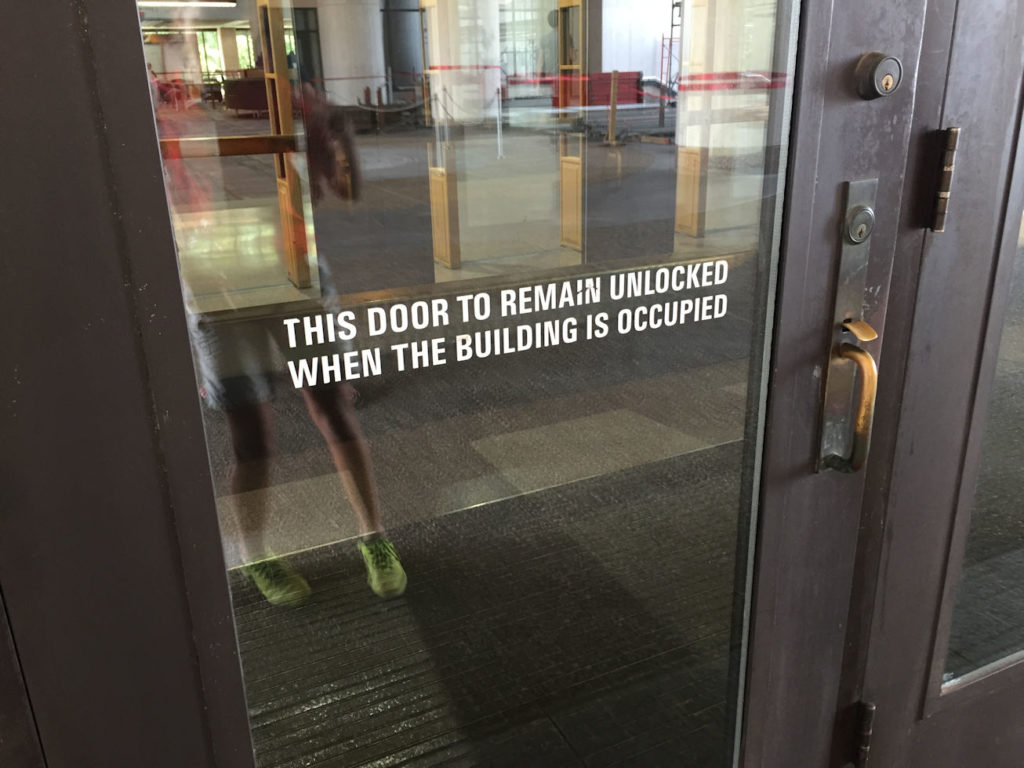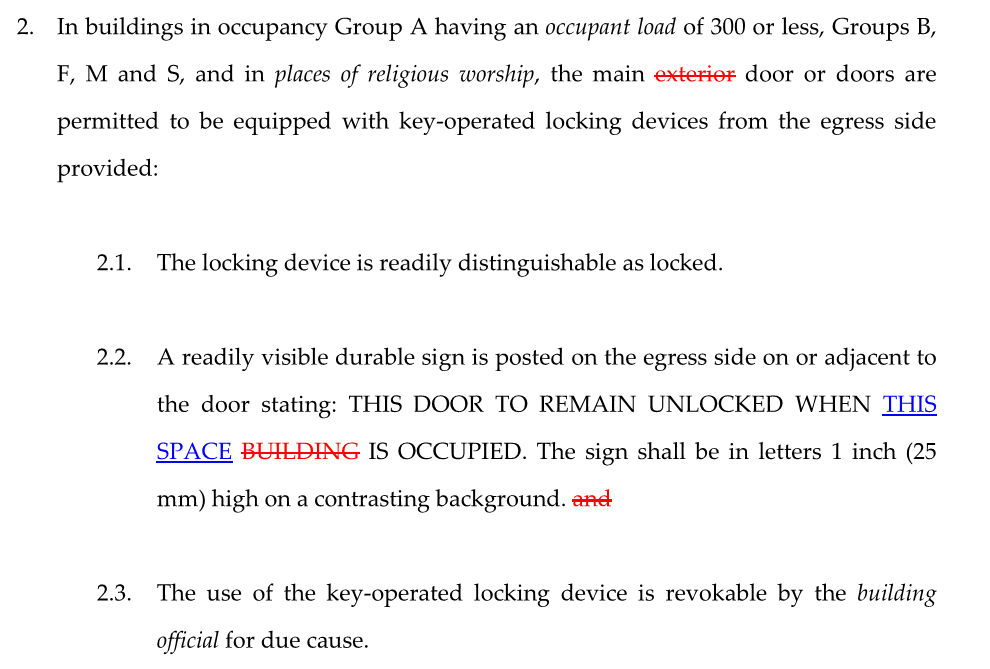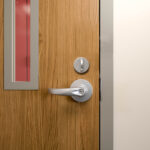Sometimes a code change is proposed, and it seems like a very simple change that couldn’t possibly be misinterpreted. What could be the harm in removing one little word? [Stick with me and keep reading.]
You may be familiar with the code requirements for key-operated locks (if not, there’s an article here). In a nutshell, this section allows a double-cylinder deadbolt on the main entrance of a building, if certain criteria are met. There are restrictions on the occupancy type, and the lock must be of a type that is “readily distinguishable as locked” (for example, the lock has an indicator). The door must also have signage stating that the door is to be left unlocked while the building is occupied.
In the 2015 edition of the International Building Code (IBC), the word “exterior” was removed from this section, and a slight change was made to the text of the signage. The image below is from the redline version of the IBC, which shows all of the changes from one version to the next and is very helpful when learning about a new edition. This is from Section 1010.1.9.3:
The purpose of this change was to allow double-cylinder deadbolts on retail stores in malls that are not exterior doors. While I do generally agree with the use of this application for retail stores in a mall, these changes have created a big opportunity for misinterpretation of the IBC.
I have been asked several times lately whether it is acceptable to install a double-cylinder deadbolt in various locations. For example, someone wanted to use a double-cylinder deadbolt to secure the door leading to a multi-stall restroom in an office building. No way – right?? Someone could get locked inside with no way to exit!
When I say “no” I like to have a code section to wave around in support of my answer (so I don’t look like the bad guy). Well, look at the new section above and tell me where it says that a double-cylinder deadbolt can’t be used on a multi-stall restroom in a business occupancy. The ONLY thing I can point to is that this application is limited to the “main door or doors” – which previously was interpreted to mean the main entrance to the building. In recent discussions, the argument has been that the restroom door is the main door to the restroom. The change to the signage sort of supports that argument by referring to “this space” rather than “this building.”
It is not the intent of the IBC to allow just any door that is the main entrance of a space, a room, or an area to be locked with a double-cylinder deadbolt. The intent is for this section to apply to the main entrance to the building, and this can be stretched to retail entrances in a mall now that the word “exterior” is gone. The premise is that the building or mall store would not be able to be open and functioning with the door locked. If we start allowing any old room or space to be locked with a double-cylinder deadbolt, it will severely impact the life safety requirements that we have worked so hard to uphold for decades.
If you have any thoughts on this – especially regarding how the code language could be modified to clarify the intent – I’d love to hear them! Comment below!
You need to login or register to bookmark/favorite this content.









Lori,
As a distributor this is an issue we face almost daily. We constantly get call requesting double cylinder deadbolts and locksets that lock on both sides. Recently, I had a customer call requesting a double cylinder deadbolt, his customer had a relative with dementia that wandered out of the house at night and wanted to lock her in to keep her “safe”.
It takes time to explain both the code and safety consideration behind the codes and most people want to buy them anyway.
Hi Jon –
The IRC requirements for single family homes require at least one egress door per dwelling unit, and that door can not have a double-cylinder deadbolt. The section from the 2018 IRC is below. Not every jurisdiction adopts the IRC, but many do. With that said, I understand the difficulty of needing to secure doors for family members who might otherwise try to leave on their own. I don’t have a great solution for that, but if you find one, let me know.
R311.2 Egress door. Not less than one egress door shall be provided for each dwelling unit. The egress door shall be side-hinged, and shall provide a clear width of not less than 32 inches (813 mm) where measured between the face of the door and the stop, with the door open 90 degrees (1.57 rad). The clear height of the door opening shall be not less than 78 inches (1981 mm) in height measured from the top of the threshold to the bottom of the stop. Other doors shall not be required to comply with these minimum dimensions. Egress doors shall be readily openable from inside the dwelling with-out the use of a key or special knowledge or effort.
– Lori
The way I read it is that the occupancy area’s main door/s. Not solely the main door to the restroom or room of the area but the actual main door/s to the whole occupancy area.
Lori, I totally agree. Perhaps we need a new sub group in the occupancy section for restrooms. At the University we only allowed classroom deadbolts on multi stall restrooms.with only a thumb turn on the inside. That way you could unlock the door from the inside if needed.
Always best to check with your local JHA or AHJ whatever side of the pond you are on.
Jurisdiction Having Authority/ Authority Having Jurisdiction.
Make them decide and sign off. I run into this constantly.
I read it as intended but can see how someone could twist it to justify what they “want” to do in other areas of the building. Would it be as simple as changing the wording to say “The main entrance door or doors are permitted….” or “The occupancy’s main entrance door or doors are permitted…”
Why didn’t they leave the code as it was and just and an exception for mall doors. Seems like that would have solved the mall issue and not caused all this confussion.
Great Post Lori!! Now that it’s been brought out that there is an interpretation problem and say that ….. I may have adopted the 2015 without this knowledge, what would my next step be to change it? Pass a local amendment reverting back to the 2012 or beyond language?? Thanks!! Keep up the GREAT work!!
Hi Kevin –
I think the easiest thing would be to issue a bulletin explaining this section of the code, and where the application will be allowed in your jurisdiction. I don’t know how difficult it would be to pass a local amendment stating the same. It all comes down to the AHJ’s interpretation, and the code language still gives the AHJ the power to deny the application. So a bulletin proactively stating the AHJ’s interpretation could help.
– Lori